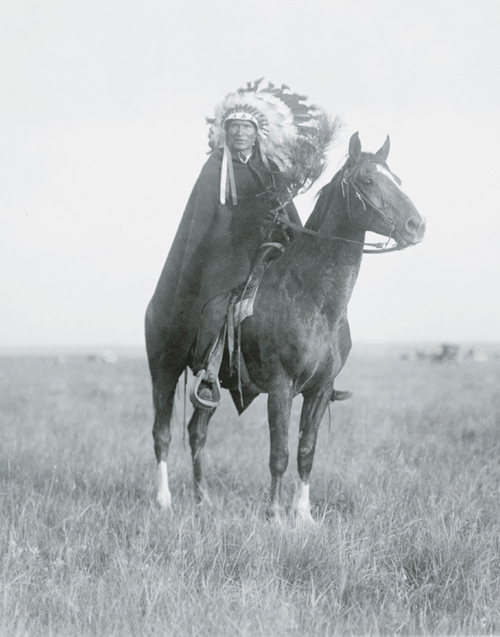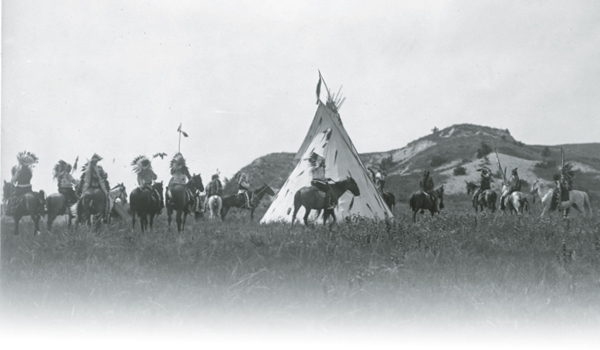

The Prairie Chief, a photograph of a Sioux warrior on horseback taken by Edward S. Curtis around 1907. With the closing of the frontier in 1890, it was widely believed that Native Americans would soon be completely assimilated into white society and their traditional customs would vanish. This resulted in a movement, particularly in photographs, to record every aspect of Indian life before it was gone. Curtis was one of the great photographers of American Indians and of the American West. [LOC, USZ62-121906]
My friends, this country that you have come to buy is the best country that we have … this country is mine, I was raised in it; my forefathers lived and died in it; and I wish to remain in it.
— CROW FEATHER OF THE SANS ARCS SIOUX

PROBABLY THE MOST FAMOUS Native American people of North America, the Sioux gave to history one of the great images of the American West: a proud Plains warrior on horse back. But the Sioux are much more than just that image. The Great Sioux Nation, known as Oceti Sakowin, or “ Seven Council Fires,” is one of the largest tribal confederations in North America. In general, its people are identified by one of their three language dialects (Dakota, Nakota, Lakota), location (the eastern Santee, central or middle Wiciyelas, and western Teton), and more specifically by their individual band or sub-band (such as Yankton or Oglala). For instance, Chief Red Cloud could be identified any one of three ways: as a Teton because he lived in the westernmost part of Sioux land, as a Lakota because this was the dialect he spoke, or as an Oglala because he was a member of that sub-band. (here.)
The name “Sioux” comes from what their enemies the Ojibwa called them: Na dou esse, which means “ Snakelike Ones” or “ Enemies.” French traders, the first to encounter both nations, spelled the Ojibwa word Nadousioux. The English and American traders, who came later, shortened it to Sioux.
The Sioux originally lived along the southeast coast of North America— the Santee River in South Carolina got its name from the Santee Sioux. They were gradually pushed west by other tribes, like the Ojibwa, who were themselves pushed west by white settlers. By the 17th century, the Sioux had settled in the north-central section of the North American continent. Like many other Native American peoples, the Sioux were nomads. They were primarily hunters, though the eastern Santees also did some farming, with buffalo being their most important source of food.

The Indian of the Plains as He Was by Charles Marion Russell, one of the great contemporary artists and sculptors of the American West. Russell greatly admired the American Indians, and his illustrations of them are distinguished by their sensitive treatment. [LOC, USZ62-115207]
Though the Sioux had chiefs who had individual leadership responsibilities (such as war chiefs), the important decisions that affected the tribe were always discussed in groups called councils. Councils included the chiefs, as well as medicine men and other respected members of the tribe. Council gatherings were always public affairs held in front of the rest of the tribe, and everyone had a right to speak.

An 1891 photograph by John C. H. Grabill of a young Oglala girl sitting in front of a tepee with her puppy. The smaller tepee on the left is probably a shelter for her dog. [LOC, USZ62-22970]
The most sacred land for the Sioux, particularly the Lakota, is Paha Sapa, the Black Hills of South Dakota. According to their tradition, it is there that Wakantanka, the Great Spirit, created them and gave them their sacred symbols and rites, including the Sun Dance.
At its height, the Great Sioux Nation stretched from Wisconsin and Minnesota to Montana and Wyoming, and from North Dakota to Iowa and Nebraska. They were proud, fierce, and feared warriors. It would take the United States government about 30 years to finally defeat them.

This 1907 Grabill photograph is titled War Preparation and shows a reenactment demonstrating how Sioux warriors got ready before they rode off to fight. [LOC, USZ62-121907]
The opening battles of that campaign would begin in the eastern part of their territory, in the Santee land of Minnesota at the same time the United States was fighting the Confederacy in the American Civil War (1861–1865).
